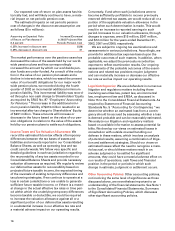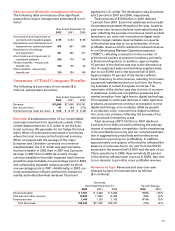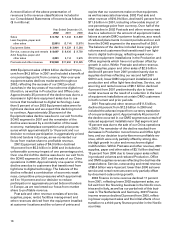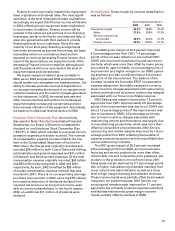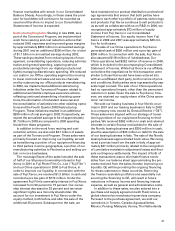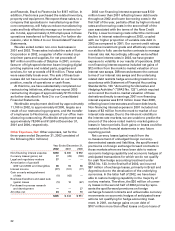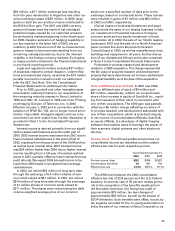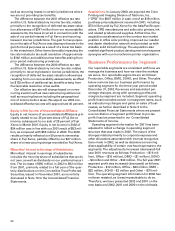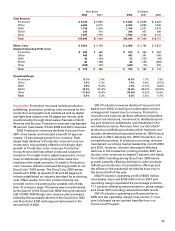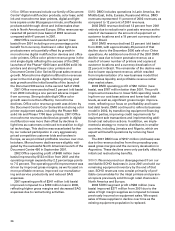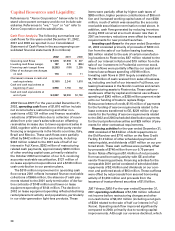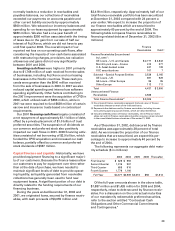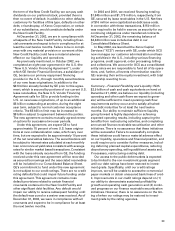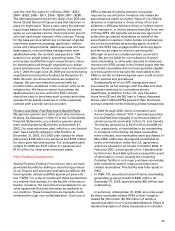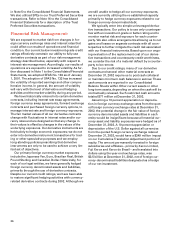Xerox 2002 Annual Report Download - page 28
Download and view the complete annual report
Please find page 28 of the 2002 Xerox annual report below. You can navigate through the pages in the report by either clicking on the pages listed below, or by using the keyword search tool below to find specific information within the annual report.
26
Office: Office revenues include our family of Document
Centre®digital multifunction products, color laser, solid
ink and monochrome laser printers, digital and light-
lens copiers under 90 pages per minute, and facsimile
products sold through direct and indirect sales chan-
nels in North America and Europe. Office revenues rep-
resented 42 percent (new basis) of 2002 revenues
compared with 41 percent in 2001.
2002 Office revenues declined 4 percent (new
basis) from 2001 including a one percentage point
benefit from currency. Declines in older light-lens
products were only partially offset by growth in
monochrome digital multifunction devices and office
color printers. Office color printer revenue grew in the
mid single digits reflecting the success of the 2002
launches of the Phaser®6200 laser and 8200 solid ink
printers and strong Phaser color printers and
Document Centre Color Series 50 post sales revenue
growth. Monochrome digital multifunction revenues
grew in the mid-single digits reflecting strong post
sale growth and the initial benefits of the launch of
the Document 500 series in the second half of 2002.
2001 Office revenues declined 2 percent (old basis)
from 2000 including a one percent adverse impact
from currency. Strong double-digit Office color
growth was more than offset by monochrome
declines. Office color revenue growth was driven by
the Document Centre Color Series 50 and strong color
printer equipment sales, including the Phaser 860
solid ink and Phaser 7700 laser printers. 2001 Office
monochrome revenues declined as growth in digital
multifunction was more than offset by declines in
light lens as customers continued to transition to digi-
tal technology. This decline was exacerbated further
by our reduced participation in very aggressively
priced competitive customer bids and tenders in
Europe, as we prioritized profitable revenue over mar-
ket share. Monochrome declines were slightly miti-
gated by the successful North American launch of the
Document Centre 490 in September 2001.
2002 Office operating profit of $498 million (new
basis) improved by $133 million from 2001 and the
operating margin expanded by 2.2 percentage points
to 7.5 percent. The operating profit improvement was
driven by improved gross margins, as we focused on
more profitable revenue, improved our manufactur-
ing and service productivity and reduced SAG
expenses.
2001 operating profit of $341 million (old basis)
improved compared to a $180 million loss in 2000,
reflecting higher gross margins and decreased SAG
expenses due to restructuring activities.
DMO: DMO includes operations in Latin America, the
Middle East, India, Eurasia, Russia and Africa. DMO
revenues represented 11 percent of 2002 revenues, as
compared to 12 percent of 2001 revenues.
2002 DMO revenue declined 13 percent from 2001
entirely due to reductions in post sale revenue as the
result of decreases in the amount of equipment at
customer locations and a 19 percent currency devalu-
ation in Brazil.
2001 DMO revenue declined 23 percent (old basis)
from 2000, with approximately 45 percent of that
decline due to the December 2000 sale of our China
operations. An additional one-third of the 2001 DMO
decline was due to lower post sale revenue, as a
result of a lower number of printers and copiers at
customer locations and a currency devaluation of
22 percent in Brazil. The remainder of the decline was
due to lower equipment revenue, which resulted
from implementation of a new business model that
emphasizes liquidity and profitable revenue rather
than market share.
2002 DMO operating profit of $62 million (new
basis), was $187 million better than 2001. The profit
improvement was due to lower SAG spending result-
ing from our cost base actions and lower bad debt
levels, as well as, significant gross margin improve-
ment, reflecting our focus on profitability and lower
bad debt levels. DMO continued to refine its business
model in 2002, by transitioning equipment financing
to third parties, improving credit requirements for
equipment sale transactions and implementing addi-
tional cost reduction actions. In addition, we imple-
mented a strategy to move to distributors in smaller
countries, including Jamaica and Nigeria, which we
expect will benefit operations by removing fixed
costs.
The 2001 DMO loss of $157 million (old basis) was
due to the revenue decline from the preceding year,
weak gross margins and the currency devaluation in
Argentina. These declines were only partially offset by
initial cost restructuring benefits.
SOHO: We announced our disengagement from our
worldwide SOHO business in June 2001 and sold our
remaining equipment inventory by the end of that
year. SOHO revenues now consist primarily of prof-
itable consumables for the inkjet printers and person-
al copiers previously sold through retail channels in
North America and Europe.
2002 SOHO segment profit of $82 million (new
basis) improved $277 million from 2001 due to the
sales of high margin supplies as compared to losses
previously incurred on equipment sales. We expect
sales of these supplies to decline over time as the
existing equipment population is replaced.


